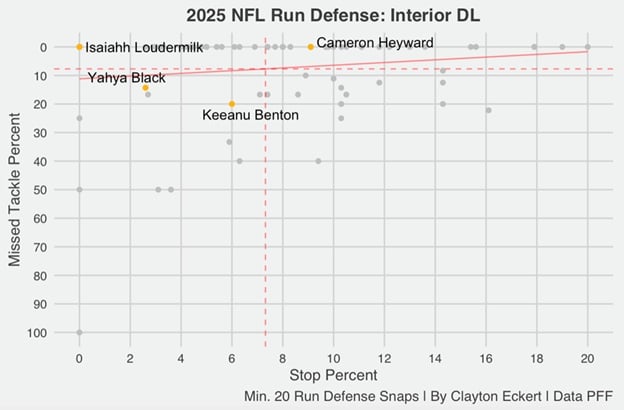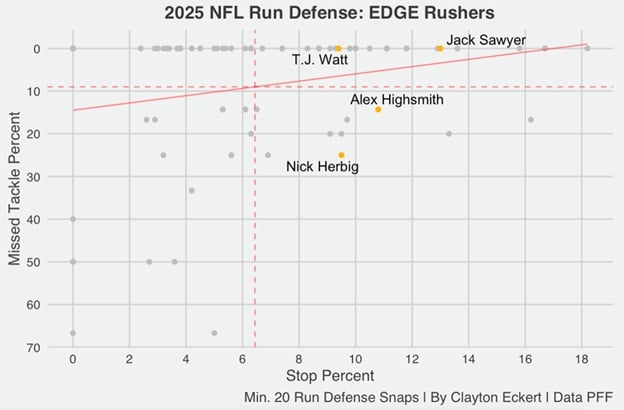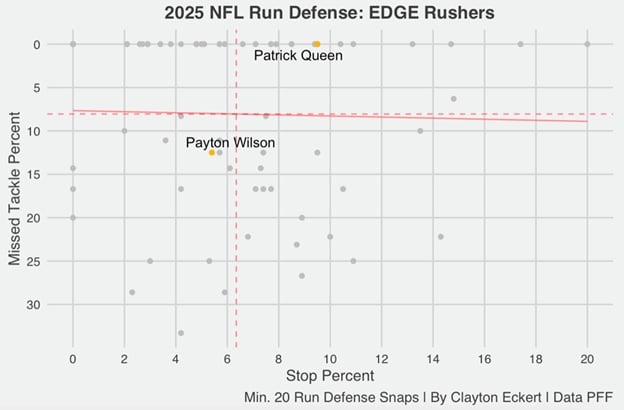The Pittsburgh Steelers’ run defense has been an issue for far too long and is an unfortunate common theme in the first two games of 2025. As a team, the Steelers rank 28th in yards and are tied for the most rushing touchdowns allowed so far. Not even close to expectations heading into the season, especially considering all the investments this offseason.
Run defense is obviously a multi-faceted challenge, including scheme, communication and of course execution. This article will focus on the latter, using a couple of stats to measure positive and negative plays against the run – stop percent (unsuccessful offensive play) and missed tackle percent. I’ll focus on players with at least 20 run defense snaps.
First up is interior defensive line (IDL):

One thing that’s likely unsurprising is that the Steelers have mostly below average stop percentages. The exception is veteran Cameron Heyward (9.1 stop percent). This ties for 33rd out of the 86 qualifiers at IDL. PFF has him charted for six solo tackles, two assists, four stops and no misses against the run (45 run defensive snaps, T-second most). Heyward ranks ninth with a 72.6 run defense grade and is certainly not the biggest culprit of the run D woes.
Pittsburgh’s other qualifiers have clearly not been run stoppers. Keeanu Benton is next in stop percent (6.0, 50th), but both data points land clearly below the mean. Paired with a lack of stops is a 20.0 missed tackle percent, tied for 74th and worst among Steelers at the position. His 51 run snaps are most in the NFL, with three solo tackles, one assist, three stops, one missed tackle and a low 46.5 run defense grade.
Hopefully Benton’s snap total will lower, with players like rookie 1st-rounder Derrick Harmon coming back soon. Benton has made plays, like an average tackle depth behind the line of scrimmage, but too volatile on the negative side (getting off blocks, missed opportunities, etc.).
Rookie Yahya Black also lands below the mean in each. A lowly 2.6 stop percent (T-72nd) namely, on three solo tackles, three assists, just one stop, 14.3 missed tackle rate (T-67th), 50.1 run defense grade, on 39 run defense snaps (T-15th). He was thrown into the fire last game as the Steelers were shorthanded and needs to trend positive for hopeful remedy.
Then there is Isaiahh Loudermilk. On first glance, landing on the upper left with no missed tackles seems positive. But despite 23 run defense snaps, he has zero run tackles. This re-emphasizes the point of Pittsburgh IDL getting pushed back and not getting off blocks enough to make stops against the run. Loudermilk is on the mounting list of defensive injuries too, placed on injured reserve post Week Two.
Next, let’s look at EDGE defenders:

Overall, a brighter picture for Pittsburgh at EDGE, expectedly. All four Steelers qualifiers land above NFL average in stop percent. Rookie Jack Sawyer’s healthy 13.0 stop percent tops Pittsburgh at the position and ranks eighth league-wide (out of 79 qualifiers). It includes four solo tackles, three stops, no assists, 64.1 run defense grade and no misses on 23 run snaps. Great to see from the young player.
Continuing this is crucial, especially considering starter Alex Highsmith suffered a high ankle sprain that could sideline him multiple games. He has Pittsburgh’s second-best EDGE stop percent (10.8, 15th), with five solo tackles, four stops, one assist, one miss for a 14.3-missed tackle percent (T-56th), and a 60.0 run defense grade on 38 run snaps.
T.J. Watt lands above the mean in both (with Sawyer). He leads all EDGEs with 54 run defense snaps, no missed run tackles and a 9.4 stop percent (23rd). Has five solo tackles, four assists and five stops. Quite impressive considering the double (and triple) teams he sees often. Watt is the highest 90.5 graded EDGE run defender, more than eight points higher than his peers despite this attention and workload.
Nick Herbig has a comparable 9.5 stop percent (T-21st) just above Watt. But the big difference is a 25.0 missed tackle percent that’s in the bottom 10 at the position. On 21 run defense snaps: two solo run tackles, two stops, one assist and one miss. His 71.7 run defense grade and behind the line average tackle depth points to hope that he (among others) can team up to fill the Highsmith void.
Now for the last front seven position – linebackers:

In these terms, we get a clear picture of who’s been better in run defense. Patrick Queen lands above average in both, with no missed run tackles and a 9.5 stop percent (T-13th) out of 72 qualifiers. Nine solo tackles, six stops, 64 run snaps (third-most), 78.6 run defense grade and two assists. While it’s been far from a perfect start to the season, Queen’s run defense isn’t the biggest reason why.
Payton Wilson, on the other hand, has struggled much more. Below the mean in each, with a 5.4 stop percent (41st) and 12.5-missed tackle percent (T-47th). Five solo tackles, three stops, two assists, one miss, and a 44.7 run defense grade (65th) on 56 run snaps (T-seventh). The latter emphasizes his full-time role, his first season to take that on, and needs to step up sooner than later.
So, the defensive line behind Cam Heyward hasn’t been up to snuff (which is obvious watching the games). Steelers EDGE rushers have been the strongest position defending the run, with Highsmith and particularly Herbig below average in missed tackle percent. At linebacker, Wilson has been the bigger culprit among starters, adjusting to doing so for the first time.
Injuries have hit the defense hard, but that’s why you have a 53-man roster, and every team deals with them. Something has to change for the Steelers, who pride themselves on run defense on both sides of the ball (article on the offense coming soon). If not, this painful trend could limit Pittsburgh’s potential yet again.


